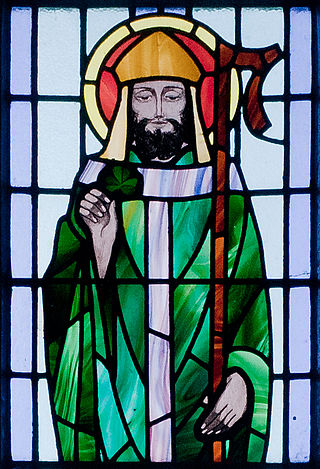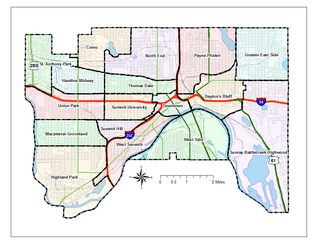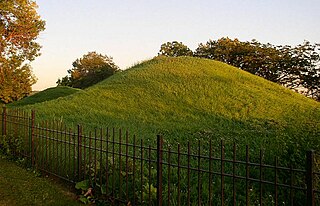
Saint Paul is the capital of the U.S. state of Minnesota and the county seat of Ramsey County. Situated on high bluffs overlooking a bend in the Mississippi River, Saint Paul is a regional business hub and the center of Minnesota's government. The Minnesota State Capitol and the state government offices all sit on a hill close to the city's downtown district. One of the oldest cities in Minnesota, Saint Paul has several historic neighborhoods and landmarks, such as the Summit Avenue Neighborhood, the James J. Hill House, and the Cathedral of Saint Paul. Like the adjacent city of Minneapolis, Saint Paul is known for its cold, snowy winters and humid summers.

Richfield is a city in Hennepin County, Minnesota. An inner-ring suburb of Minneapolis, Richfield is bordered by Minneapolis to the north, Minneapolis–Saint Paul International Airport and Fort Snelling to the east, Bloomington to the south, and Edina to the west. The population was 36,994 at the 2020 census.

Saint Patrick's Day, or the Feast of Saint Patrick, is a religious and cultural holiday held on 17 March, the traditional death date of Saint Patrick, the foremost patron saint of Ireland.

John Ireland was an American religious leader who was the third Roman Catholic bishop and first Roman Catholic archbishop of Saint Paul, Minnesota (1888–1918). He became both a religious as well as civic leader in Saint Paul during the turn of the 20th century. Ireland was known for his progressive stance on education, immigration and relations between church and state, as well as his opposition to saloons and political corruption. He promoted the Americanization of Catholicism, especially in the furtherance of progressive social ideals. He was a leader of the modernizing element in the Roman Catholic Church during the Progressive Era. He created or helped to create many religious and educational institutions in Minnesota. He is also remembered for his acrimonious relations with Eastern Catholics. See St Alexis Toth

Pierre "Pig's Eye" Parrant, or Pierre Parent, was the first person of European descent to live within the borders of what would eventually become the city of Saint Paul, Minnesota. His exploits propelled him to local fame and infamy, with his name briefly adorning the village that would one day become Minnesota's capital city.

The Archdiocese of Saint Paul and Minneapolis is a Latin Church ecclesiastical jurisdiction or diocese of the Catholic Church in the United States. It is led by an archbishop who administers the archdiocese from the cities of Saint Paul and Minneapolis. The archbishop has both a cathedral and co-cathedral: the mother church – the Cathedral of Saint Paul in Saint Paul, and the co-cathedral, the Basilica of Saint Mary in Minneapolis.
Thomas Robert Byrne was an American politician in Minnesota. He was the Democratic mayor of Saint Paul from 1966 to 1970. He was Catholic and fully Irish. He served in the U.S. Army Air Force in World War II. He was a member of the American Legion and the Veterans of Foreign Wars.
William Dawson, was mayor of Saint Paul, Minnesota, United States, from 1878 to 1881. He was born in County Cavan, Ireland on October 1, 1825. He was a successful banker. When he was elected as mayor, he became the first mayor to be Irish in Saint Paul. He died on February 19, 1901. He died poor after his Bank of Minnesota failed five years before he died. There is a two-acre park named after him in Saint Paul. He is the namesake of the city of Dawson, Minnesota.

Cretin-Derham Hall High School (CDH) is a private, co-educational Catholic high school in Saint Paul, Minnesota operated by the Archdiocese of Saint Paul and Minneapolis. It is co-sponsored by the Brothers of the Christian Schools and the Sisters of St. Joseph of Carondelet.

Minneapolis is the largest city by population in the U.S. state of Minnesota, and the county seat of Hennepin County. The origin and growth of the city was spurred by the proximity of Fort Snelling, the first major United States military presence in the area, and by its location on Saint Anthony Falls, which provided power for sawmills and flour mills.

Saint Paul, Minnesota, consists of 17 officially defined city districts or neighborhoods.

Dayton's Bluff is a neighborhood located on the east side of the Mississippi River in the southeast part of the city of Saint Paul, Minnesota which has a large residential district on the plateau extending backward from its top. The name of the bluff commemorates Lyman Dayton, for whom a city in Hennepin County was also named. On the edge of the southern and highest part of Dayton's Bluff, in Indian Mounds Park, is a series of seven large aboriginal mounds, 4 to 18 feet high, that overlook the river and the central part of the city.
Edward Phelan, also Phalen or Felyn (c.1811-1850), was an early settler of Saint Paul, Minnesota. Phelan was born in approximately 1811 in Derry, Ireland and later became, along with John Hays and William Evans, one of the first settlers of Saint Paul. Phelan was later accused of Hays' murder, the first ever in Saint Paul, but was acquitted. He was indicted for perjury a year later but fled to California before he could be prosecuted. Phelan was killed by his companions in what they describe as self-defense before he could reach California. Many locations in Saint Paul, Minnesota are named after Phelan as a result of his early land claims. Phelan's name was spelled variously and as a result most locations are named Phalen and not Phelan

Saint Paul is the second largest city in the U.S. state of Minnesota, the county seat of Ramsey County, and the state capital of Minnesota. The origin and growth of the city were spurred by the proximity of Fort Snelling, the first major United States military installation in the area, as well as by the city's location on the northernmost navigable port of the Upper Mississippi River.

West Seventh is a neighborhood in Saint Paul, Minnesota, United States. This area is colloquially known as the West End, and is not to be confused with the West Side, a different neighborhood. The West End lies at the base of Summit Hill and along the western bluffs of the Mississippi River, spanning the entire length of West Seventh Street, or Old Fort Road; it is also known as the Fort Road area. Fort Road was a historic Native American and fur trader path along the Mississippi River from downtown Saint Paul to Fort Snelling.

Thomas Reed Potts was an American physician, civic leader and the first Mayor of St. Paul, Minnesota. After graduating from medical school, Potts moved across the country and eventually found his way to the young settlement of St. Paul. Active in civic life and popular in his medical practice, he was elected as the first President of the Town Board. Despite a successful tenure, he tired of politics and retired after one term to continue his practice; however he did hold several key health-related positions. By the time of his death, he was the oldest doctor in the city and one of its most respected.

Saint Patrick's Day, although a legal holiday only in Savannah, Georgia, and Suffolk County, Massachusetts, is nonetheless widely recognized and celebrated throughout the United States. It is primarily celebrated as a recognition of Irish and Irish American culture; celebrations include prominent displays of the color green, eating and drinking, religious observances, and numerous parades. The holiday has been celebrated in what is now the U.S since 1601.

Corcogemore at 609 metres (1,998 ft), is the 208th–highest peak in Ireland on the Arderin scale, and the 253rd–highest peak on the Vandeleur-Lynam scale. Corcogemore is located on a small massif that includes Binn Mhór, and Mullach Glas ; this massif is situated at the far southeastern sector of the long north-west to south-east central spine of the Maumturks mountain range in the Connemara National Park in Galway, Ireland. Corcogemore is the 8th-highest peak in the Maumturks range, and the most southerly in the range; after Lackavrea, Corcogemore is the 2nd-most easterly Maumturk.

Union Park is a neighborhood in Saint Paul in the U.S. state of Minnesota. Created as a merger of several historic neighborhoods including Merriam Park, Snelling-Hamline, Parts of Midway, Densoyer Park, and Lexington-Hamline, it is bordered by University Avenue on the north, Lexington Parkway on the east, Summit Avenue on the south, and the Mississippi National River and Recreation Area on the west. Despite the merger, many of the historic neighborhoods hold onto their original identity, especially in Lexington-Hamline and Merriam Park.

















